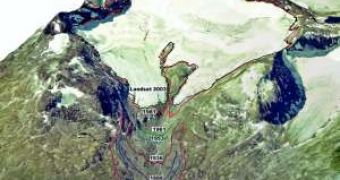Glaciers are a very sensitive indicator of climate change. "Glaciers react quickly to changes in temperature and precipitation, and provide much useful information to climate researchers," said Liss Marie Andreassen, glaciologist at the Norwegian Water Resources and Energy Directorate (NVE).
The Storbreen (Big Glacier)(photo), one of the largest Norwegian glaciers, in Jotunheimen National Park, has melted 500 meters since measurements began in 1949 and 60 meters (200 feet) since 1997. Years of warmer and prolonged summers and poor snowfall have left cloven Bretunga, the lower tip of the glacier. "The glacier is now clearly divided in two. Less than ten years ago it was completely joined there at the bottom," said Andreassen.
Today, all Norwegian glaciers are on the retreat, losing length and volume, and the trend started at the beginning of the 20th century. A recent research predicted that out of the 1,600 glaciers existent today in Norway, only about 30 will stand over a century.
Andreassen does not totally agree. "There is no doubt that many of the smaller glaciers will disappear if global warming continues. And many of the larger glaciers will greatly decrease in volume. But saying something about the situation in 100 years is difficult."
More precipitations might help mountain glaciers hold on or even grow. "It depends on how warm it will be and how much precipitation falls. For example, it isn't unthinkable that there will be significantly more precipitation in the mountains in coming years. In this case it would lead to better conditions for coastal glaciers," she said.
About 98 % of Norway's electricity is produced by hydropower and glacial runoff is vital to a lot of the dammed rivers. "About 15 % of the water power comes from water systems with significant amounts of glacial water, and in drier years glaciers regulate water flow" said Andreassen.
Photo credit: NVE

 14 DAY TRIAL //
14 DAY TRIAL // 
